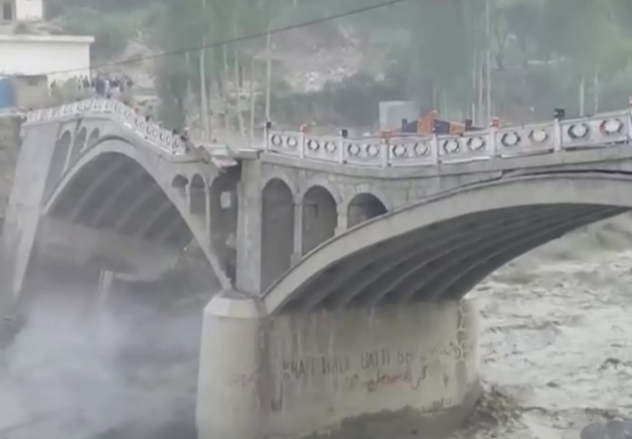Dramatic footage shows enormous bridge crumbling amid raging floodwaters

Pakistan and neighboring India have been sweltering amid an intense heat wave that has led to weeks of dangerous air quality and rampaging wildfires. Now, the early-season heat is to blame for causing the rapid melt of the Shishper Glacier in northern Pakistan, which led to destructive flooding downstream.
The Hassanabad Bridge in Pakistan's Hunza Valley was completely destroyed on Saturday as the melting glacier sent torrents of water coursing through area streams in a phenomenon known as a glacial lake outburst flood.
Dramatic footage showed concrete blocks crumbling and eventually giving way under the punishing pressure of the raging floodwaters. Observers might typically associate such scenes with extremely heavy rainfall rather than the impacts of rapidly melting glaciers.
The destroyed bridge cut the connection between northern Pakistan and China on the Karakoram Highway, a popular tourist attraction famed for being one of the highest paved roads in the world.
 |
A snapshot of Hunza's Hassanabad bridge in the process of collapsing as floodwaters raged underneath. (Reuters) |
Local law enforcement confirmed the developments of the destroyed bridge on Twitter, stating that small vehicles were being diverted to Sas Valley Road.
The floodwaters also swept away two power plants in Hassanabad, according to Dawn.com, a Pakistani news outlet. Officials were evacuating individuals living in vulnerable locations near the floodwaters and supplying provisions.
In mid-May 2019, NASA highlighted the Shishper Glacier, predicting that the Karakoram Highway, large numbers of homes in the village of Hasanabad, important irrigation channels and two power plants could all be affected in the event of a severe flood.
Over the past 21 days, the water volume at the Shishper glacier lake increased by 40% as a result of an unusual early-season spike in temperatures, Reuters reported.
#Shishper glacial lake outburst flood in #Hunza has damaged an important bridge on #KKH at #Hassanabad.
The light transport/traffic has been diverted to alternate route on SAS Valley Road but heavy transport vehicles are not allowed.
For further information dial 1422. pic.twitter.com/9eeqBUzRuH— Tourist Police Gilgit-Baltistan (@GBPolice1422) May 7, 2022
Although official weather observations are sparse in this particular part of the country, temperatures at other high-elevation sites in northern Pakistan have repeatedly hit the upper 80s and 90s F (30-37 C) over the past couple of weeks. Farther south at lower elevations, temperatures have repeatedly eclipsed 110 F (43 C), which is on the order of 5-10 degrees Fahrenheit (3-6 degrees Celsius) above average.
Pakistan's Federal Minister for Climate Change, Sherry Rehman, said in late April that Pakistan went from winter to summer, without much of a spring, for the first time in decades.
A temporary bridge is slated to be completed within a month, with construction of a new bridge expected to be completed in six to eight months, a local newspaper reported.
"Pakistan has the highest number of glaciers outside the polar region, and many are losing mass due to high global temperatures," Rehman said.
AccuWeather meteorologists say no relief is in sight for the foreseeable future across the region with searing heat projected to continue past the middle of May.
Want next-level safety, ad-free? Unlock advanced, hyperlocal severe weather alerts when you subscribe to Premium+ on the AccuWeather app. AccuWeather Alerts™ are prompted by our expert meteorologists who monitor and analyze dangerous weather risks 24/7 to keep you and your family safer.
